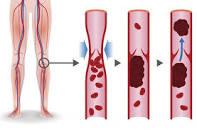Leave a Comment:
1 comment
[…] Blood Clot- Increase Risk of Multiple Myeloma Diagnosis? […]
Reply
Multiple Myeloma an incurable disease, but I have spent the last 25 years in remission using a blend of conventional oncology and evidence-based nutrition, supplementation, and lifestyle therapies from peer-reviewed studies that your oncologist probably hasn't told you about.
Click the orange button to the right to learn more about what you can start doing today.

I received a multiple myeloma diagnosis in early 1994. I underwent conventional therapies, radiation, chemotherapy and an ASCT, in the years following that diagnosis. I developed a deep vein thrombosis (DVT) weeks after I began my first course of chemotherapy.
Blood clots are both a symptoms of MM as well as a side effect of MM. Can a blood clot/DVT increase your risk of a multiple myeloma diagnosis? The article linked and excerpted below says yes.
I’ve written about blood clots caused by MM and/or chemo repeatedly on PeopleBeatingCancer.org. Never have I written about a DVT increasing the risk of a multiple myeloma diagnosis.
According to the article linked below, if you are diagnosed with a blood clot you are at a higher risk of cancer.
Please go see your doctor if you think you have a DVT. Have him/her look you over for multiple myeloma.
Good luck
David Emerson
Arterial thrombosis is the formation of a thrombus within an artery. In most cases, arterial thrombosis follows rupture of atheroma (a fat-rich deposit in the blood vessel wall), and is therefore referred to as atherothrombosis. Arterial embolism occurs when clots then migrate downstream, and can affect any organ.[citation needed]
Alternatively, arterial occlusion occurs as a consequence of embolism of blood clots originating from the heart (“cardiogenic” emboli). The most common cause is atrial fibrillation, which causes a blood stasis within the atria with easy thrombus formation, but blood clots can develop inside the heart for other reasons too.[citation needed]
“Multiple myeloma is considered a hypercoagulable state due to several mechanisms such as:
We describe a case of a female patient who presented to the hospital with pulmonary embolism as the first manifestation of the hypercoagulability of multiple myeloma…
Apart from having an increased risk of pulmonary embolism due to immunomodifying agents that are included in multiple myeloma therapy, patients with newly diagnosed multiple myeloma, that is prior to having received therapy, seem to be at increased risk for venous thromboembolic disease and pulmonary embolism…”
“Patients with the most acute type of thrombosis in the leg — known as an arterial thrombosis — risk developing diseases that are far worse than the blood clot itself. The risk of developing cancer during the first six months after the blood clot is three times greater than normal...
“It is especially, but not only, the smoking-related forms of cancer that show up after the arterial thrombosis. The risk is highest for lung and pancreatic cancer, both of which are related to smoking. However, other forms of cancer such as colon cancer and leukemia are also overrepresented,” says Jens Sundbøll about the research results…
In the study, Jens Sundbøll observes that the cancer risk is continuously increased but decreases in strength over time. After the first six months with 3-fold increased risk compared with a control group without blood clots, it falls during the next six months to ‘only’ a forty percent increased risk. Once the first year after the blood clot has passed, the risk of cancer is continuously 15 percent increased…
“It is well known that early treatment is crucial for the prognosis of many types of cancer, and our findings show that an arterial thrombosis in the leg is associated with an increased risk of cancer to the same degree as a deep venous thrombosis — both absolutely and relatively speaking…
The study “Risk and Prognosis of Cancer after Lower Limb Arterial Thrombosis” is based on the 6,600 Danes who were diagnosed with an arterial blood clot in the leg during the period 1994-2013. Of them, 772 were diagnosed with cancer during the twenty-year period…
In a research context, the fact that cancer patients have a significantly increased risk of blood clots is well-established, and it can therefore be asked whether it is the active, yet undiagnosed, cancer that causes the arterial blood clot in the leg, or whether the blood clot facilitate the formation of a latent cancer. The answer is that we do not know…
[…] Blood Clot- Increase Risk of Multiple Myeloma Diagnosis? […]
Reply